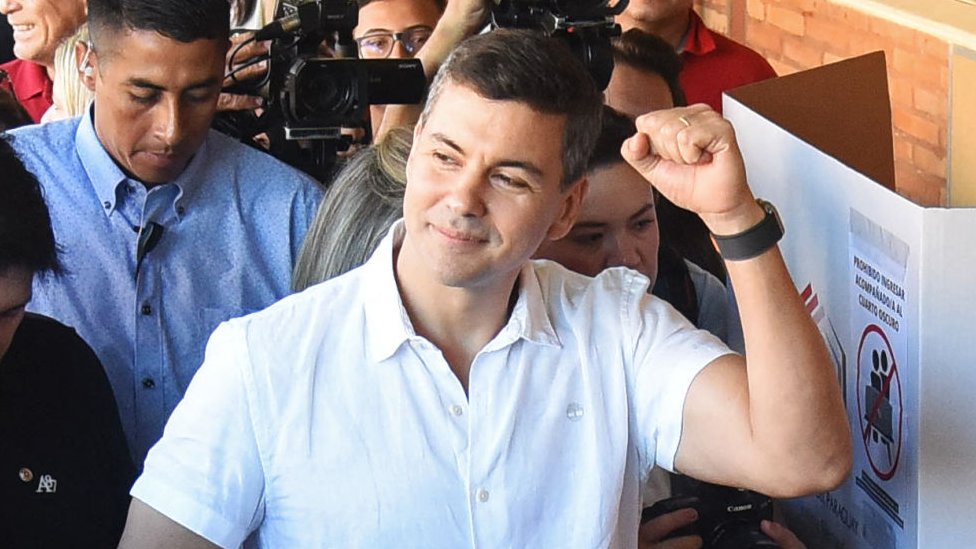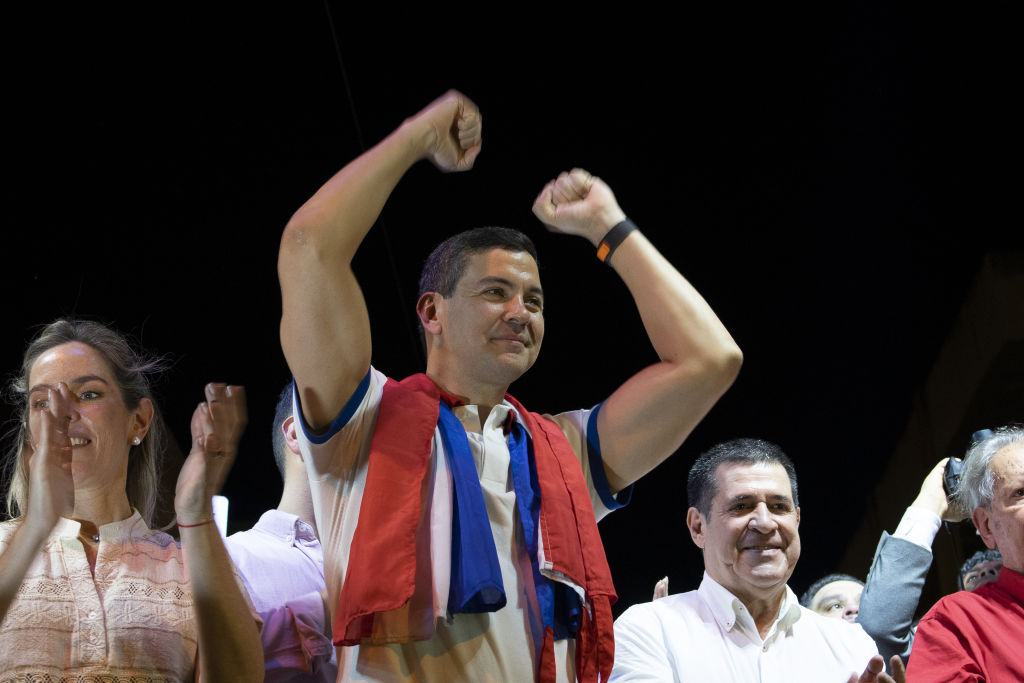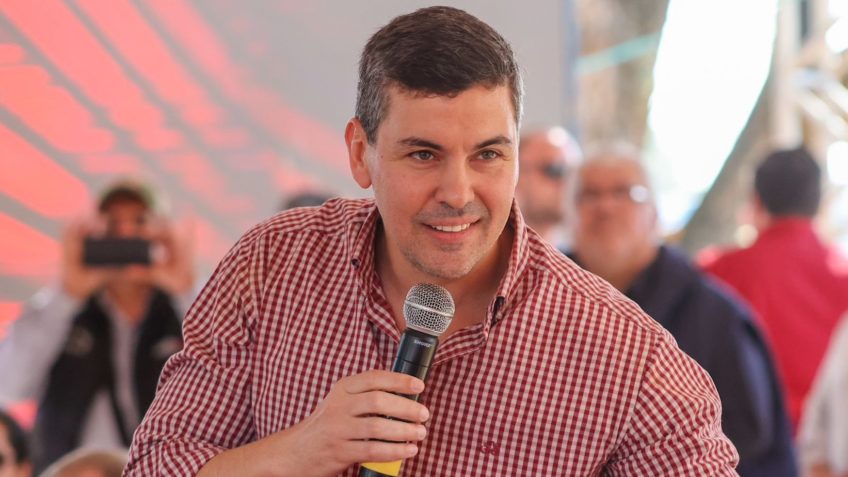Latin America
Related: About this forumOperation Sweetness: Paraguay finds four tons of cocaine stashed in sugar in its biggest drug bust yet
By Associated Press
4:29pm Jul 17, 2024
Authorities in Paraguay announced on Tuesday the largest cocaine seizure in the country's history after officials were surprised to find more than four tons of the drug stashed inside a shipment of sugar bound for Belgium.
President Santiago Peña told journalists that the record discovery, code-named "Operation Sweetness," added to a string of "very sad episodes" in Paraguay that had transformed the strategically located nation into a key drug trafficking hub in the region.
Peña expressed hope that the seizure, valued at roughly $US240 million ($AU 356 million), would disrupt the cocaine trade and said police were pursuing those responsible.
. . .
"Gangs are not going to be able to avoid all the controls that we are implementing."
More:
https://www.9news.com.au/national/paraguay-finds-four-tons-of-cocaine-stashed-in-sugar-in-operation-sweetness/aab2922a-f7db-45b9-ab08-7fd6710bdfc4
~ ~ ~
Colorado Party (Paraguay)
National Republican Association – Colorado Party (Spanish: Asociación Nacional Republicana – Partido Colorado, ANR-PC, lit. 'Red Party') is a conservative political party in Paraguay, founded on 11 September 1887 by Bernardino Caballero. Since 1947, the colorados, as they are known, has been dominant in Paraguayan politics (ruling as the only legal party between 1947 and 1962) and has controlled the presidency since 1948 –notwithstanding a brief interruption between 2008 and 2013– as well as having a majority in both chambers of Congress and department governorships.
With 2.6 million members as of 2022 (although there are allegations of numerous false affiliations made by the party),[17] it is the largest political party in the country, usually ruling without the necessity of electoral alliances.
. . .
The Colorado Party became the dominant political force in the country following the conclusion of the 1947 civil war. During this time, the party operated multiple paramilitary wings. From 1947 until 1962, the Colorado Party ruled Paraguay as a one-party state; all other political parties were illegal.[18] In 1962, all national parties were nominally legalized; the Communist Party being deemed "international" remained illegal and its adherents repressed by the Paraguayan state. During the rule of Alfredo Stroessner all members of the armed forces and government employees were required to be members of the Colorado Party. Dissident groups within the party were purged, and two (Movimiento Popular Colorado and Asociación Nacional Republicana en el Exilio y la Resistencia) acted as opposition groups in exile until the 1980s. In 1987, there was a rift in the party between a hardliner faction supportive of Stroessner and a traditionalist faction.[19] This rift was primarily over the issue of Stroessner's succession and was a large contributor to the 1989 coup d'état led by General Andrés Rodríguez, himself a traditionalist.[20]
In practice, however, Paraguay remained a one-party military dictatorship until Stroessner's overthrow in 1989. It served as one of the "twin pillars" of Stroessner's 35-year rule, one of the longest in history by a non-royal leader.[21]
More:
https://en.wikipedia.org/wiki/Colorado_Party_(Paraguay)
Paraguayan President,
Santiago Peña, conservative
Colorado Party (as always)




"Having speaks" with Argentina's happy conservative statesman President Milei

Blue Owl
(58,128 posts)Judi Lynn
(164,047 posts)It won't copy and paste, gotta click the link.
https://tinyurl.com/3sftsk6w
(He might want to invest in a retired drug dog sometime)
Judi Lynn
(164,047 posts)Paraguay's awful history
The never-ending war
How a terrible but little-known conflict continues to shape and blight a nation
He died with his homeland
Dec 22nd 2012|asunción
Share
He died with his homeland
THE fall of the “father of all Paraguayans” was even more abrupt than his rise. In 2008 Fernando Lugo, a Catholic bishop and liberation theologian who called himself a champion of the poor, won his country’s presidential election and broke the Colorado Party’s chokehold on power. Shortly after his inauguration, however, four women said that he had fathered their children while under a vow of celibacy; Mr Lugo recognised two of them. The Liberal party, whose support had propelled him to the presidency, repudiated him. In June 2012 Congress summarily removed him from office, after he was accused of mishandling a clash between police and landless peasants.
. . .
But Mr Lugo’s career highlights other aspects of the war’s legacy. His election was widely celebrated because it ended 61 years of unbroken rule by the Colorado Party, 35 of them under Alfredo Stroessner. It was under Stroessner that the cult of López reached its apex. “The emphasis on glory, self-sacrifice, authoritarian models and internal enemies felt very congenial to the stronistas,” says Mr Whigham, the historian. Stroessner’s state “legitimised itself by drawing a straight line between Big Al and the Marshall.”
Wartime depopulation also influenced Stroessner’s policies. Post-war governments distributed brochures offering immigrants a free trip to Paraguay and land. A series of Utopian colonies sprung up, including a “New Australia” and an Aryan-supremacist “Nueva Germania”, co-founded by Friedrich Nietzsche’s sister, where a German flag still flies. In 1931 descendants of that group set up the first Nazi party outside Germany. (At the start of the second world war, Paraguay’s government openly sympathised with Hitler. The national police director named his son Adolfo Hirohito; police cadets wore swastikas on their uniforms.)
Another German who came to Paraguay after the war was Stroessner’s father, a Bavarian. Stroessner himself had no direct ties to the Paraguayan Nazis, but he shared many of their instincts: in 1974 he was accused by the UN of committing genocide against the native Aché people. He also harboured numerous Nazi war criminals, including Josef Mengele.
This autocratic tradition may have influenced Mr Lugo’s dismissive attitude to other politicians—a crucial factor in his downfall. The Liberals abandoned him in part because they felt their support had not been adequately rewarded in policies and jobs. Instead Mr Lugo had packed his cabinet with leftist allies. “You get in with one group and govern with another,” he reportedly said.
. . .
Sexual violence during the war itself poisoned attitudes to race. In its own way, Paraguay is a melting pot: the countryside is full of blond-haired, blue-eyed peasants who speak fluent Guaraní and halting Spanish. Yet López’s propagandists tried to drum up prejudice against the Brazilian army, which was mostly black, since Pedro promised to free slaves who fought. They called the emperor the “chief of the monkey tribe”. The resentment lingers. “The kambá raped our women,” says Miguel Ángel of the Piribebuy museum, using the Guaraní word for blacks. Legend has it that the resulting black babies were killed.
More:
https://www.economist.com/christmas-specials/2012/12/22/the-never-ending-war
Or:
https://web.archive.org/web/20240701003947/https://www.economist.com/christmas-specials/2012/12/22/the-never-ending-war
blue-wave
(4,816 posts)Here's a link to some pics of a Nazi rally in Argentina circa 1938:
https://rarehistoricalphotos.com/nazi-rally-argentina-1938/
The Peron's were also Nazi sympathizers. No wonder the "Conservative" presidents from both countries like each other so much.
Judi Lynn
(164,047 posts)

It was interesting to see this caption under one of the photos:
I have often wondered if somehow Trump hasn't consulted psy-ops people for pointers on mind-control for his public appearances, since he clearly controls those freaks! I've pondered on the strange patronizing voice tricks he uses, and his ultra-weird hand gestures, etc. They never seem to realize he is an idiot.
The photos are horrendous. I had no idea the Nazi movement was that strong in Argentina during the 1930's.
Thanks for sharing the link. hi:
Judi Lynn
(164,047 posts)From Wikipedia:
There are 17 indigenous tribes in Paraguay with the majority having their territories in the Chaco region. Tribes in this region include the Guaraní, Ayoreo, Toba-Maskoy, Aché and Sanapan which according to the census from 2002 number an estimated 86,000 or roughly around 2 per cent of the total population. These peoples have faced persecution particularly under the dictator Alfredo Strossner that some observers called a genocide.
Repression under Alfredo Stroessner
Between 1956 and 1989, while under the military rule of General Alfredo Stroessner, the indigenous population had more territory taken than at any other period in Paraguay's history and were subjected to systematic human rights abuses. In 1971, Mark Münzel, a German anthropologist accused Stroessner of attempted genocide against the indigenous peoples of Paraguay[1] and Bartomeu Melià, a Jesuit anthropologist stated that the forced relocations of the indigenous peoples was ethnocide.[2] In the early 1970s the Stroessner regime was charged by international groups of being complicit in genocide. However, because of the repressive actions undertaken by the state the indigenous tribes organized themselves politically and had a major role in bringing about the end of the military dictatorship and the eventual transition to democracy.[3][2][4] The state financed these repressive actions with U.S. aid, which totaled $146 million from 1962 to 1975 to Paraguay.[5]
Destruction of the Ache tribe
During the 1960s and 1970s, 85 percent of the Aché tribe died, with many hacked to death with machetes to make room for the timber industry, mining, farming and ranchers.[6] One estimate posits this amounts to 900 deaths.[7] According to Jérémie Gilbert, the situation in Paraguay has proven that it is difficult to provide the proof required to show "specific intent", in support of a claim that genocide had occurred. The Aché, whose cultural group is now seen as extinct, fell victim to the development by the state, who had promoted the exploration of Aché territory by transnational companies for natural resources. Gilbert concludes that though planned and voluntary destruction had occurred, it is argued by the state that there was no intent to destroy the Aché, as what had happened was due to development.[8]
Assessment of persecution as a genocide
The allegation of genocide by the state was brought before the Inter-American Human Rights Commission which has jurisdiction on allegations of genocide carried out by a state. The commission gave a provisional ruling that Paraguay had not carried out a genocide, but stated it had concerns over "possible abuses by private persons in remote areas of the territory of Paraguay".[9] The Whitaker Report of the United Nations listed the persecution of the Aché as an example of genocide.[10]
More:
https://en.wikipedia.org/wiki/Genocide_of_Indigenous_peoples_in_Paraguay
Judi Lynn
(164,047 posts)Dictatorship of Alfredo Stroessner
. . .
On 4 May 1954 Stroessner ordered his troops into the streets and staged a coup. Fierce resistance by police left almost fifty dead.[2]
As the military strongman behind the coup, Stroessner was able to place his supporters in positions of power in the provisional government. He then quickly made moves to secure power for himself. About two months later, a divided Colorado Party nominated Stroessner as their presidential candidate for the 1954 elections. The Colorados had been the only legally permitted party since 1947, so this effectively made Stroessner president. For many party members he was a temporary choice, as Morínigo had been for the Liberals in 1940. When Stroessner took office on 15 August 1954, few imagined that this circumspect, unassuming forty-one-year-old would be a master politician capable of outmaneuvering and outlasting them all—[2] or that they were witnessing the start of the fifth and longest of Paraguay's extended dictatorships.
Early rule
The use of political repression, threats and death squads was a key factor in Stroessner's longevity as dictator of Paraguay. He had virtually unlimited power by giving a free hand to the military and to Minister of Interior Edgar Ynsfrán, who began to harass, terrorize, and occasionally murder family members of the regime's opponents.[2]
Stroessner's rule took a hard-line stance from the beginning. Soon after taking office, he declared a state of siege, which gave him the power to suspend constitutional freedoms. Under the state-of-siege provisions, the government was empowered to arrest and detain anyone indefinitely without trial, as well as forbid public meetings and demonstrations. It was renewed every 90 days until 1987, except for a brief period in 1959. Although it technically only applied to Asunción after 1970, the courts ruled that anyone charged with security offenses could be brought to the capital and charged under the state-of-siege provisions—even if the offense took place outside the capital.[3][4] Thus, for all intents and purposes, Stroessner ruled under what amounted to martial law for nearly all of his tenure.
The retirement of González and the death of Molas López had removed two of his most formidable opponents and the September 1955 Argentine coup that deposed President Perón deprived Méndez Fleitas of his main potential source of support. Perón fled to Asunción and the new Argentine junta compelled Perón to depart Asunción for Panama in November. Méndez Fleitas prepared to stage a coup in late December. As a result, Stroessner purged the military of Méndez Fleitas' supporters and sent him into exile in 1956.[2]
Stroessner was at the time barely in control of the Colorado Party, which was split in competing factions by rival politicians, while the army was also not a dependable supporter of his rule. The economy was in bad shape and deteriorating further, with inflation growing. His economic austerity measures proved unpopular with the nation's military officers, who had long grown used to getting soft loans from the Central Bank; with fiscally dodgy businessmen, who disliked the severe tightening of credit; and with increasingly poor workers, who organized 1958 Paraguayan general strike demanding increased pay. In addition, the new Argentine government, displeased with Stroessner's cordial relations with Perón, canceled a trade agreement with Paraguay.[2]
Guerillas
1958 elections gave Stroessner the second Presidential term. The vote was fixed to favor the regime and opposition blossomed into a guerrilla insurgency soon afterwards. Sponsored by exiled Liberals and febreristas, small bands of armed men began to slip across the border from Argentina. Venezuela sent large amounts of aid to these groups starting in 1958. The following year, the new Cuban government under Fidel Castro also provided assistance to the United National Front.[2]
The guerrillas received little support from Paraguay's conservative peasantry. The Colorado Party employed its own militias, the peasant py nandí irregulars ("barefoot ones" in Guaraní) had a well-deserved reputation for ferocity in combat, torture and executing their prisoners. Growing numbers of people were interned in jungle concentration camps. Army troops and police smashed striking labor unions by taking over their organizations and arresting their leaders.[2]
More:
https://en.wikipedia.org/wiki/Dictatorship_of_Alfredo_Stroessner

Dictator Alfredo Stroessner with Spain's fascist dictator Francisco Franco

Dictator Alfredo Stroessner with US President Nixon's blood-thirsty Chilean Dictator Augusto Pinochet